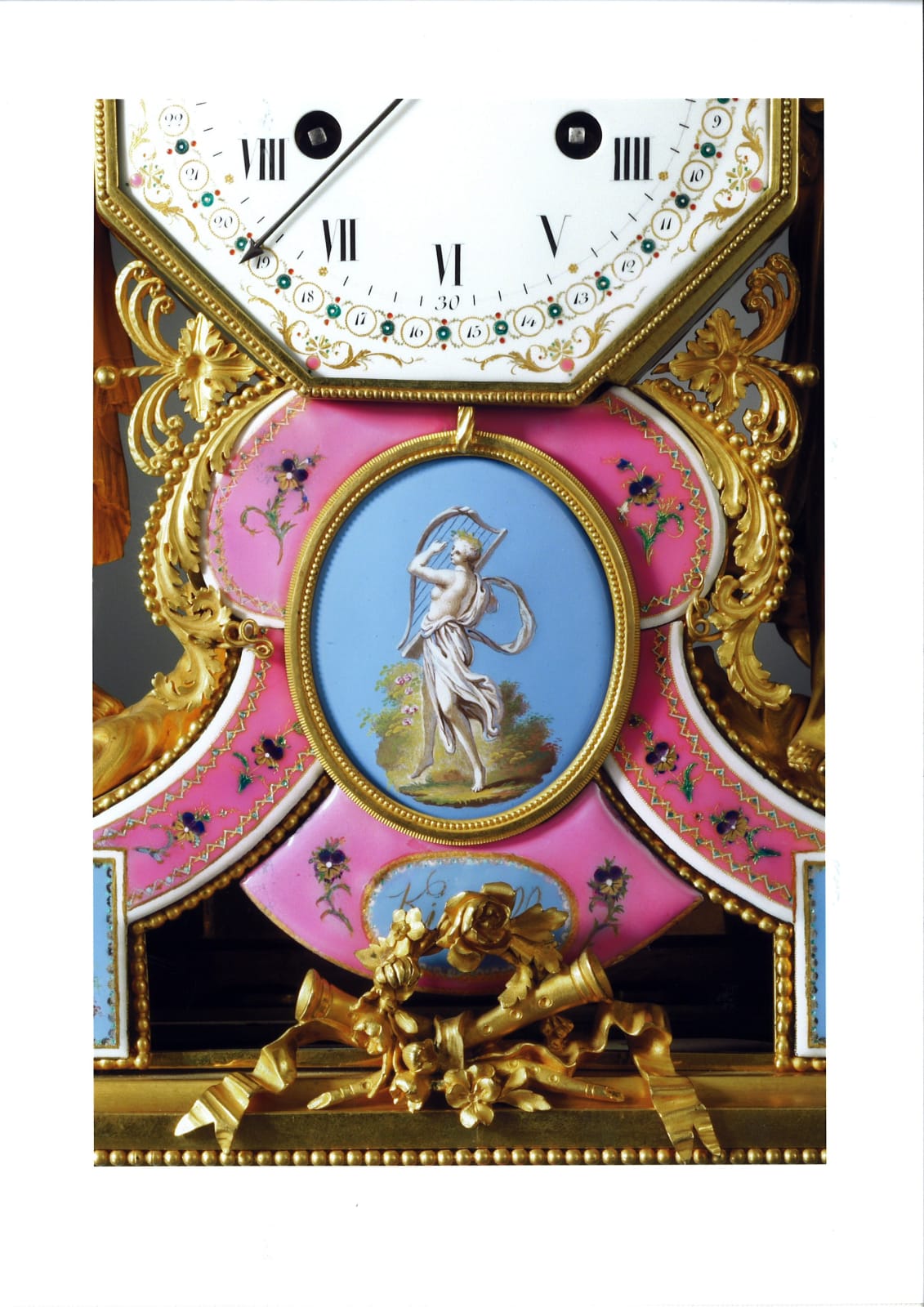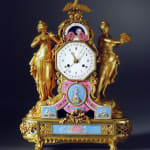Joseph Coteau French, 1740-1812
Literature
Jean-Dominique Augarde, "Les Ouvriers du Temps", 1996, p. 342, illustrating this clock. Tardy, "Les Plus Belles Pendules Françaises", 1994, pp. 210-211, illustrating an identical clock in the Ecole d'Horlogerie de Dreux.
A magnificent late Louis XVI gilt bronze and polychrome enamel mantel clock of eight day duration, the exquisite enamel work by Joseph Coteau and movement by Dieudonné Kinable, signed below the lunar dial Coteau invéf.t and on the reverse of one of the enamel plaques Coteau / No.5, also signed on an enamel plaque within the apron below the dial Kinable and on the reverse rue paupe no. 7 / quart saint andré. The octagonal white enamel dial with Roman and Arabic numerals and outside Arabic numerals 1-31 for the days of the month set within gilt and polychrome lozenges interspersed by foliate and beaded decorations, the dial corners painted with foliate scrolls, with beautiful pierced gilt brass hands for the hours and minutes and a blued steel pointer for the calendar indications, the main dial surmounted by a subsidiary lunar dial with Arabic numerals for the 29 ½ days of the lunar month and a beautifully painted moon with gilt fleur-de-lis pointer set against a gold star studded dark blue ground.
The movement with anchor escapement, silk thread suspension, striking on the hour and half hours, with outside count wheel. The magnificent trellis-pierced case backed with later blue silk surmounted by an eagle with spread wings representing Jupiter upon a cloud, drapery and floral trails around the main dial, the latter flanked by a pair of contrapposto classically draped female Bacchantes, the one to the left with a double flute, the other with a tambourine, both standing on clouds cast with further musical instruments, flanking below the dial an arched frame decorated with floral sprays on a pink ground and centred by a pale blue oval plaque with a gilt and grisaille classical female playing the harp above a pair of similarly painted square enamel plaques depicting scenes of Cupid and Psyche, on a gilt bronze rectangular base with trellis-pierced rounded ends hung with floral swags, with a central floral enamel frieze plaque on four lion paw feet
Paris, date circa 1785
Height 51 cm, width 37 cm.
This superb clock demonstrates the virtuosity and innovative skills of the enamel painter Joseph Coteau (1740-1812), combined with those of the renowned Parisian clockmaker Dieudonné Kinable (d. after 1815). Its importance also relies on the fact that few surviving clocks of this period combine such exquisite enamel decorations within a highly sculptural gilt bronze case. More usually one finds plaques of this type on skeleton clocks or clocks of a simpler design generally without figural statuettes, such as a clock, likewise by Kinable and enamelled by Coteau in the collection of the Newark Museum (illustrated in W. Edey, "French Clocks in North American Collections", 1982, p. 91-92, pl. 87). A skeleton clock, with similar but simpler enamel work by Coteau and movement by Laurent is illustrated in Augarde, op.cit. p. 340, pl. 255, which includes the same scenes of Cupid and Psyche in grisaille.
Coteau, along with Dubuisson (b. 1731 d. after 1815) was the finest artist to perfect jewelled enamelling. Born in Geneva, he became a maître-peintre-émailleur at the Académie de Saint-Luc in Geneva, 1766. By 1772 he was established at rue Poupée in Paris and in 1785 was accepted as a maître of his Parisian guild. Coteau also worked for Sèvres, he was instrumental in the development of jewelled porcelain and discovered a new method for gilt-decorated enamels "d'appliquer solidement l'or marié avec les émaux de toutes couleurs sur la porcelaine", which cleverly mimicked porcelain plaques as evident on this clock. With such skill, Coteau only supplied the greatest clockmakers of his day. Among them was Dieudonné Kinable, of Palais Royal no. 131 who was also supplied by Dubuisson and distinguished himself for his enamelled skeleton and lyre clocks. Between 1795 and1806 he acquired 21 lyre-shaped cases from Sèvres, which in turn he supplied to royalty, examples of which can be found in British Royal Collection.
JOSEPH COTEAU (1740-1812). FRENCH
Painted enamel and porcelain dials became increasingly popular during the reign of Louis XVI, reaching perfection in the hands of Joseph Coteau and Gobin Etienne (known as Dubuisson). Coteau was born in Geneva, Switzerland but is known to have practised his specialised craft in Paris. During his maturity he was established at Rue Toupee in the parish of Sant-Andre-des-Arts, where he remained until his death. At the age of 23 he produced the dial for a musical clock by Daille, horologer to Madame la Dauphine, 1763(Wallace Collection, London). Coteau attained such repute that he only ever supplied to the most eminent horologists, including Antide Janvier (1751-1835), Robert Robin (1742-1809) and Ferdinand Berthoud (1727-1807). He is also known to have decorated pieces of jewellery.
Coteau clock dials have a characteristic style, due as much to their superior quality as to their subject. His most distinct decoration consisted of delicate numerals with small garlands of flowers but more usually with signs of the zodiac, each element worked as an individual miniature. Other dials had little or no extra ornament except for the classical Louis XVI style numerals, such as his dial for the Avignon Clock, 1771 (Wallace Collection, London), with the movement by Delunesy and elaborate gilt bronze case sculptured by Louis-Simon Boizot (1743-1809) and executed by Pierre Gouthiere (1732-C.1812). At other times Coteau supplied decorative bands to accompany clock cases, such as an enamel frieze around a vase adorning one of Robert Robin's elaborate clocks, c.1780 (Wallace Collection, London). The band, painted in grisaille, depicts the seasons personified by infants playing and is interspersed by four cameo heads. A similar clock was supplied to Marie Antoinette for Chateau St. Cloud. Decorative dials and their accompanying complex quality movements fell in demand during the Revolution, however Coteau was patronised by the new government to create a number of Republican ten hour dials.
It appears that Coteau never enamelled watches or small scale pieces but specialised in larger works, which were technically more complex due to shrinkage during firing. The techniques required a high degree of skill to achieve a perfect finish. Coteau experimented with various polychromes, producing a blue that was so rare and complex that few if any of his contemporaries managed to copy. The enamel paint was applied with a brush onto a copper plate and the various colours vitrified one by one in a muffle kiln. The decoration was then enhanced by delicate gilding, which after firing resulted in a matt finish, the gilding was finally burnished to restore its metallic brightness.
Coteau dials are extremly rare, they are sometimes "secretly" inscribed on the reverse, in either pen or bruch. In addition to their scarcity and their supreme quality, his dials and enamel plaques only accompanied the most complex quality mechanisms. For these reasons his work is a tru prize and significantly enhances the value of any clock. Examples of his work can be found in a number of European museums, including Mobilier National, Musee des Arts Decoratifs, Paris; Carnavelet Museum, Dijon Museum, and in London at the Wallace Collection and Victoria and Albert Museum.
Copyright by Richard Redding , Zurich, all rights reserved.



